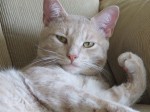 There is a lot of confusion around how often a domesticated cat should be fed. Most cats are either free-fed or fed only once or twice a day, and convenience to the owner is the driving factor.
There is a lot of confusion around how often a domesticated cat should be fed. Most cats are either free-fed or fed only once or twice a day, and convenience to the owner is the driving factor.
But is this good for the cats?
Let’s look at the science first. According to the Nutrient Requirements of Dogs and Cats by the National Research Council, feral cats eat about 8 to 12 meals in any given 24 hour period. Their behavior is geared towards small, frequent meals and they spend a great deal of their time actively hunting.
Their digestive physiology is affected by their eating habits. Smelling food triggers a cat’s digestive system to begin working, and constantly smelling food – as free-fed cats do – keeps that system primed and ready to go all day. Like all physiological functions, the GI tract requires energy to operate; constantly keeping it “on” pulls resources from other systems and, depending upon the quality of nutrition the cat routinely receives, can cause problems including premature aging, poor coat quality, and chronic cystitis.
In addition, a carnivore’s digestive physiology has incorporated hunger as an integral part of its healthy workings. Indigestible solids are retained in the stomach until digestion of other food products is completed and it is, in fact, hunger pangs which propel this material forth. If the cat is never allowed to become hungry, the regulation of waste movement is compromised, leading to discomfort, hairball regurgitation and other digestive issues.
Clearly, then, free-feeding is not a healthy practice. (And this does not even touch upon the content of the products so freely available to kibble-fed cats, or the many links between that content and today’s leading causes of feline disease and death. See No Kibble! for more on that.)
On the other end of the spectrum, the cat’s stomach can’t expand like the dog’s to accommodate large meals, and cats can – and often do – regurgitate if fed too much at one time, as might happen with a cat fed only once or twice daily.
Eating too fast, which cats tend to do when they are very hungry, can also cause discomfort and regurgitation of the meal.
Too, as the cat becomes hungry, bile acids in the stomach increase in anticipation of a meal. If this goes on too long or becomes concentrated enough, the cat is likely to become nauseous, provoking what many have termed “hunger pukes”, typically of a clear or foamy consistency. “Too long” varies with the cat, but can be as short as 5 or 6 hours. Unfortunately for some cats, this puking can start a spiral of discomfort that will throw a cat off food indefinitely.
In all of these cases, even when the cat doesn’t become actively sick, she’s probably not feeling quite as comfortable as she should.
Obviously, then, if 5 or 6 hours is the baseline, feeding only once or twice a day isn’t a good idea either.
So how often should a cat be fed?
My recommendation is a minimum of three times a day for adults, four if you can manage it, and at least four times a day for kittens. It’s easy to do if you feed shortly after you rise in the morning, immediately after you arrive home from work, and last thing before you retire for the night.
If your schedule disallows this, you can either pay for someone to come by during the day, or purchase one of the many timed feeders available on the market today… several of which are capable of disseminating canned or raw foods (the only foods I recommend feeding your cat).
Stick to a routine, as this will help enormously in managing feline stress levels and is very beneficial for that and other reasons, and feed as large a rotation of low-carb canned or raw foods as you can get your hands on (more on the benefits of rotating foods in a future post).
Feeding three scheduled low-carb canned or raw meals a day will go a long way toward keeping your cat’s digestive system healthy, strong, and working at peak efficiency!

